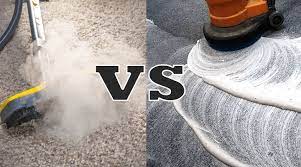Introduction to Carpet Shampooing
Carpet shampooing stands out as a supreme method to elevate the cleanliness and prolong the lifespan of commercial carpets. This process entails the use of shampoo to release and raise dirt from the carpet fibers, making it simpler to eliminate once the carpet dries. Notably, the cleanliness of the carpet improves progressively with regular vacuuming, as it continues to remove the suspended soil.
Understanding the various techniques for shampooing carpets is crucial, especially as professional jargons can be easily misinterpreted. In this comprehensive guide, we will delve into the professional approach on how to shampoo carpet, employing the correct equipment, solutions, and tools to ensure a meticulously clean carpet.
 Hand wash the carpet. Carpet washing manually. Close-up.
Hand wash the carpet. Carpet washing manually. Close-up.
Distinguishing Between Shampooing and Steam Cleaning
It’s common to interchangeably use terms like “carpet shampoo” and “steam cleaning,” yet they reflect significantly different cleaning practices. Steam cleaning, or hot water extraction, involves the use of hot water and high pressure to clean carpets, often mistaken due to the steam that may appear during the process.
Conversely, shampooing carpet involves a rotary brush carpet cleaning machine that administers shampoo and works the foam into the carpet fibers. This method is particularly effective for commercial carpets requiring interim maintenance, where the cleaning residue is vacuumed upon drying. For extremely soiled carpets, combining shampooing with hot water extraction can yield an exceptionally thorough cleaning.

The Importance of Shampooing Carpets
Commercial carpets bear the brunt of heavy foot traffic, accumulating a plethora of dirt, dust, and allergens. This not only detracts from the visual appeal of a business but can also degrade indoor air quality and contribute to health issues among occupants. Regular shampooing ensures the carpet remains visually appealing and hygienic, thereby extending its service life. Implementing a comprehensive maintenance program that spans daily, periodic, and restorative cleaning procedures is essential for maintaining optimal carpet condition.
Step-by-Step Guide on How to Shampoo a Carpet
- Preparation: Begin with a thorough pre-vacuuming to remove any dry soil and debris, setting the stage for an effective shampooing process.
- Shampoo Application: Mix cleaning shampoo with water at a ratio of 8 oz per gallon and fill the rotary shampoo brush machine’s tank. Target a 4ft x 4ft area and methodically clean using a circular motion, ensuring the foam diminishes as you proceed. Repeat this process across the entire carpet area, section by section.
- For Deep Cleaning: In cases of heavily soiled carpets, follow with hot water extraction for an intensified cleaning effect.
- Post-Cleaning Care: If the carpet is of the cut pile variety, use a Carpet Brush after cleaning to enhance its appearance and aid in drying. Utilize Floor Dryers to expedite the drying process.
- Safety Measures: Always conduct a colour fastness test, adhere to the product’s label directions, and avoid mingling products unless explicitly instructed.
Frequency of Carpet Shampooing in Commercial Settings
The frequency of shampooing depends heavily on the carpet’s location and its susceptibility to dirt. High-traffic areas may necessitate shampooing 1–2 times a month, whereas less trafficked areas might only require shampooing every six months. Regular maintenance is paramount, even if the carpet appears clean to the naked eye, to ensure deep-seated dirt and grime are effectively managed.
The Verdict on Homemade Carpet Cleaning Solutions
While homemade cleaning solutions might suffice for minor spots or stains, they can’t substitute the comprehensive cleaning that professional carpet shampooing delivers. For minor stain treatment, a blend of warm water, white vinegar, and a few drops of dish soap can be used, but for maintaining the overall health and appearance of commercial carpets, professional shampooing is indispensable.
Shampooing carpet is not just about cleanliness; it’s an investment in the durability and visual appeal of your commercial space. By embracing the methods outlined in this guide, you can ensure your carpets remain pristine and inviting, contributing to a positive impression and a healthier indoor environment.





Comments